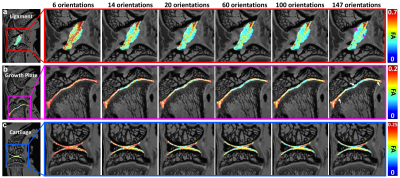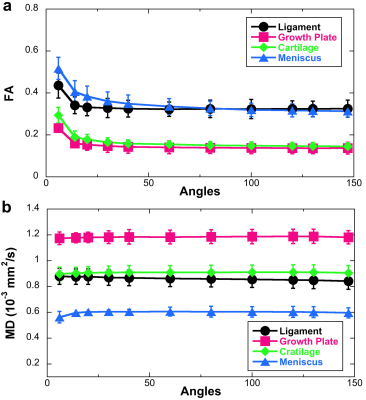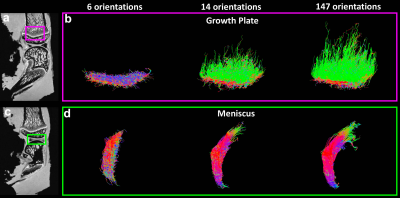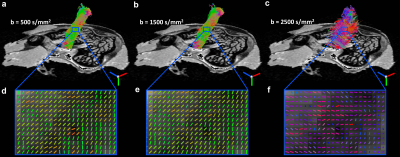2975
Effects of Angular Resolution and b Value on Diffusion Tensor Imaging in Knee Joint
Qi Zhao1, Rees P. Ridout1, Jikai Shen1, and Nian Wang2
1Duke University, Durham, NC, United States, 2Radiology and Imaging Sciences, Indiana University, Indianapolis, IN, United States
1Duke University, Durham, NC, United States, 2Radiology and Imaging Sciences, Indiana University, Indianapolis, IN, United States
Synopsis
Diffusion MRI and tractography in the musculoskeletal system has recently attracted more and more attention to investigate the connective tissue microstructure, local collagen fiber alignment, and the 3D collagen fiber network. Although diffusion tractography was successfully performed in some individual regions of knee, investigating the effects of the acquisition parameters for the whole joint are still lack.
Synopsis
Diffusion MRI and tractography in the musculoskeletal system has recently attracted more and more attention to investigate the connective tissue microstructure, local collagen fiber alignment, and the 3D collagen fiber network. Although diffusion tractography was successfully performed in some individual regions of knee, investigating the effects of the acquisition parameters for the whole joint are still lack.Purpose
To investigate the influences of the diffusion gradient directions (angular resolution) and the strength of the diffusion gradient (b value) on DTI metrics and tractography of various connective tissues in knee joint.Introduction
The knee joint is the largest and one of the most complex joints in human body1. It includes various types of tissues, including articular cartilage, meniscus, ligament, muscle, tendon, etc2. Diffusion tensor imaging (DTI) allows to quantify the water molecular diffusion properties and calculate the orientation of the principal eigenvector3. Fiber tractography has opened an entire new window to investigate the anatomical connections in brain, kidney, spinal cord4-6. We systematically investigated the influences of two important experimental factors on the DTI metrics and tractography in knee joint. We aimed to provide a coherent baseline for the different factors that can influence the measurement of DTI in knee joint.Methods
Two rat knee joints were scanned on a preclinical 9.4T system using a 3D diffusion-weighted spin echo pulse sequence. The scan parameters: TR = 100 ms, matrix size = 400 × 256 × 256, FOV = 18 × 11.52 × 11.52 mm3, 45 µm isotropic spatial resolution. One protocol with b value of 500, 1500, and 2500 s/mm2 were acquired separately using 43 diffusion gradient directions. The other protocol with b value of 1000 s/mm2 were performed using 147 diffusion gradient directions. Fractional anisotropy (FA) and mean diffusivity (MD) were compared at different angular resolution. Tractography was quantitatively evaluated at different b values and angular resolutions in cartilage, ligament, meniscus, and growth plate.Results
Figure 1 showed the FA maps of ligament, growth plate, and cartilage at different angular resolution. The FA values were largely overestimated at the angular resolution of 6 for all three types of tissues. Figure 2 illustrated the FA (a) and MD (b) profiles of different connective tissues as the function of angular resolution. FA values reached a plateau when the angular resolution is higher than 14 for ligament, growth plate, and cartilage, while higher than 40 for meniscus. Compare to FA, MD showed less sensitivity to the angular resolution. Figure 3 showed the tractography results in growth plate and meniscus at different angular resolution. Tractography was failed in all the regions with 6 diffusion gradient directions. Tractography with higher angular resolution showed more intact and organized fiber tracts. The similar results were found in articular cartilage and ligament (data not shown). Figure 4 showed the quantitative tractography metrics of different connective tissues in knee joint, including cartilage, growth plate, ligament, and meniscus. Both tract length and volume rose steeply when the angular resolution reached to 40, and then increased mildly when the angular resolution was higher than 40. To investigate the effect of b value, diffusion tractography of ligament at b value of 500 s/mm2, 1500 s/mm2, and 2500 s/mm2 were illustrated in Figure 5, respectively. The tracts and collagen fiber directions were visually comparable at b value of 500 s/mm2 and 1500 s/mm2. The fiber orientation estimation and the fiber tractography failed at b value of 2500 s/mm2, probably due to the lower single-to-noise ratio (SNR).Discussion and Conclusion
We have systematically explored the effects of b value and angular resolution on DTI performance at different connective tissues in knee joint. The tract length and volume are sensitive to both the b value and angular resolution, which demands care in interpretation. In order to obtain consistent DTI outputs and tractography in knee joint, the scan may require a proper b value (ranging from 500 s/mm2 to 1500 s/mm2) and sufficient angular resolution (14 or higher) with SNR (>10). Please note that changing b values normally will affect the SNR, which should be considered for the setup of DTI acquisitions.Acknowledgements
This work was supported through the NIH/NIBIB National Biomedical Technology Resource Center P41 EB015897. The work is also supported by Charles E. Putman MD Vision Award of the Department of Radiology, Duke University School of Medicine (Nian Wang and Charles E. Spritzer).References
1. LaPrade RF, Engebretsen AH, Ly TV, Johansen S, Wentorf FA, Engebretsen L. The anatomy of the medial part of the knee. J Bone Joint Surg Am. 2007 Sep;89(9):2000-10.2. Dargel J, Michael JW, Feiser J, Ivo R, Koebke J. Human knee joint anatomy revisited: morphometry in the light of sex-specific total knee arthroplasty. J Arthroplasty. 2011 Apr;26(3):346-53.3. Basser PJ, Mattiello J, LeBihan D. Estimation of the effective self-diffusion tensor from the NMR spin echo. J Magn Reson B. 1994 Mar;103(3):247-54.4. Mori S, van Zijl PC. Fiber tracking: principles and strategies - a technical review. Nmr Biomed. 2002 Nov-Dec;15(7-8):468-80.5. Wang N, Zhuang J, Wei H, Dibb R, Qi Y, Liu C. Probing demyelination and remyelination of the cuprizone mouse model using multimodality MRI. J Magn Reson Imaging. 2019 Dec;50(6):1852-65.6. Vedantam A, Jirjis MB, Schmit BD, Wang MC, Ulmer JL, Kurpad SN. Diffusion tensor imaging of the spinal cord: insights from animal and human studies. Neurosurgery. 2014 Jan;74(1):1-8;Figures

Figure 1. The FA maps of ligament, growth plate, and articular cartilage at different angular resolution. The FA values were largely overestimated with the angular resolution of 6. The values showed visually little differences when the angular resolution is higher than 14. Higher FA values were found in the center part of the ligament (purple arrows). Lower values were found in the center part of growth plate (white arrows).

Figure 2. The FA (a) and MD (b) profiles of different connective tissues as the function of angular resolution. FA values reached a plateau when the angular resolution is higher than 14 for ligament, growth plate, and cartilage, while higher than 40 for meniscus. Compare to FA, MD showed less sensitivity to the angular resolution.

Figure 3. Tractography results in growth plate (a and b) and meniscus (c and d) at different angular resolution. Tractography with higher angular resolution showed more intact fiber tracts. Tractography was failed in all the regions with the minimum diffusion tensor imaging model requirement (angular resolution of 6).

Figure 4. Tract length (a-d) and tract volume (e-h) of different connective tissues in knee joint, including cartilage, growth plate, ligament, and meniscus. Both tract length and volume increased steeply when the angular resolution was lower than 40, and tract length and volume mildly increased when the angular resolution was higher than 40.

Figure 5. Diffusion tractography of ligament at different b value. The tracts (a, b) and collagen fiber directions (d, e) were visually comparable between b value of 500 s/mm2 and 1500 s/mm2. Both fiber direction estimation and tractography failed at b value of 2500 s/mm2 (c, f).